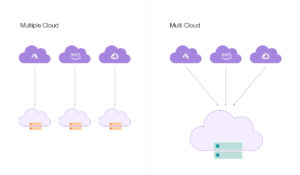Reinvent. Refurbish. Rewire: Is It Time for A Digital Makeover?
 By Anita Srinivasan
By Anita Srinivasan
 19th September, 2023
19th September, 2023
Digital Transformation Roadmap
Digital Transformation Trends
Digital Transformation Solutions
Digital transformation is not just a technological upgrade but a holistic rethinking of how a business operates, interacts with customers, and remains competitive in the digital age. It requires strategic planning, investment, and a commitment to ongoing adaptation and improvement.
A study by Gartner reveals that 91% of businesses are involved in digital initiatives, with 87% of senior business leaders saying digitalization must be a priority for all organizations. (1)
People can interpret the term digital transformation in many ways. It basically means bringing technological capabilities to a process or an entire organization for competitive advantage, improved customer experience and lower operational costs. Artificial intelligence, cloud computing, the Internet of Things (IoT), and data analytics are some technologies used when adopting digital transformation initiatives.
Digital transformation needs consistent long-term efforts to completely transform organizational operations, address improvement areas and upgrade tech capabilities.
It correlates largely with the terms digitization and digitalization:
The Gartner IT Glossary describes digitization as changing from analog to digital form, also known as digital enablement. In other words, digitization takes an analog operation and changes it to a digital format without any different-in-kind changes to the process itself.
Transforming all manual data into digital data to eliminate paperwork, conveniently store data, and reduce human errors is called digitization. Tasks such as scanning financial records and storing them as PDFs on a computer or cloud server are digitization.
The Gartner IT Glossary explains digitalization as using digital technologies to change a business model and provide new revenue and value-producing opportunities; it can be defined as moving to a digital business.
Digitalization means automating business operations to enhance efficiency and profitability. For instance, incorporating intelligent process automation to improve tracking, communication, and version control of creative projects is an example of digitalization. It involves a fundamental re-evaluation and restructuring of how you conduct your business, which includes digitization and digitalization.
Expanding on the role of automation in digitalization, Georg Tacke, CEO and Annette Ehrhardt, Global Head of Communications and Marketing Senior Director at Simon-Kutcher & Partners, believe “Digitalization increases process efficiency and enhances data transparency along with giving your top line a boost. If a company operates an online platform, then the company may already be 80 percent digitalized. It gives way for increased efficiency and customer value by remaining 20 per cent of the way.”
HOW IS DIGITAL TRANSFORMATION DIFFERENT FROM DIGITALIZATION?
Digitalization and digital transformation are two different concepts. An organization can carry out digitalization projects that involve automating processes and using digital tools.
However, digital transformation is not a project to be undertaken in isolation. It is a customer-focused strategic plan that requires an organization-wide change and the implementation of digital technologies.
Digital transformation comprises several digitalization initiatives, but leaders and company executives are under the false impression that digital transformation only involves digitalization. It is a grave strategic mistake on their part.
Digital transformation is a complex process that changes how an organization operates. It involves developing a change mindset and making transformation a core competency as the enterprise becomes customer-driven end-to-end. This agility is essential for ongoing digitalization initiatives but should not be confused with them.
Each stage of the process, from digitization to digitalization and digital transformation, is necessary but insufficient for the next level of the rewiring process. Understanding the distinction between these terms is crucial for organizations that want to embrace digital transformation and thrive in the digital age.
Now that we have clearly defined each of these definitions. Let us look at some of the capabilities we must tap into for a successful digital transformation:
- Strategy Development – A well-defined strategy is the first step to enhance overall business value. Specific areas for transformation must be looked into by companies, namely customer experience, processes, or functions that generate significant value for the business. Organizations must adopt a roadmap-driven strategy outlining the solutions and resources needed to deliver change to specific domains.
- Expertise – A knowledgeable and expert team makes the digital transformation process a worthwhile investment for your organization. Hiring and retaining digital talent is crucial. Employees within the organization must possess the skills and knowledge to leverage digital technologies. Training and upskilling programs can help these bridge skill gaps. The collaborative approach from digital talent and business professionals gives way to a successful digital transformation journey.
To learn more about Digital Transformation best practices and strategies, download our exclusive Case Study resource for detailed insights.
- IT Infrastructure and Integration -A robust IT infrastructure that supports the integration of new digital tools and technologies is essential. Legacy systems may need to be updated or replaced to ensure compatibility with modern digital solutions.
- Data Analytics -Data is of primary importance in the digital transformation journey. The ability to collect, analyze, and derive insights from data allows organizations to make informed decisions, personalize customer experiences, and identify growth opportunities.
- Change Management– Successful Digital transformation often requires a significant cultural shift within an organization. Change management strategies, templates and methodologies help employees adapt to new working conditions and embrace necessary technologies.
For insights on Change Management Approaches, please download our Change Management Strategy resource for improved implementation.
- Scalability and Flexibility – Digital transformation should be scalable to accommodate growth and adaptable to newer technologies. Scalable solutions ensure that the organization can grow without significant operational disruptions.
ROLE OF AI IN DIGITAL TRANSFORMATION
The role of Artificial Intelligence, especially Generative AI (Artificial Intelligence) is significant in the digital transformation process. A clear understanding of specific business requirements and goals is a prerequisite to derive maximum benefits from these technologies.
With the influx of new technology trends, it is easy to get sidetracked. We must focus on the potential value derived from these technologies to meet specific organizational requirements.
To leverage Generative AI capabilities, organizations require essential components for digital transformation. They need a well-defined strategy, expertise, and a responsive and scalable operating model. Generative AI also requires constant re-evaluation of roadmaps and prioritized solutions for updated models to support business objectives.
HOW TO START YOUR DIGITAL TRANSFORMATION JOURNEY
To embark on a digital transformation journey, here are a few factors to keep in mind-
- Clearly Defined Goals – It is necessary to clearly define your digital transformation goals and objectives and establish what you have set out to achieve in your organization. This vision will guide your efforts and provide a sense of direction.
- Assess Your Current Tech -A thorough evaluation of your current technology stack, processes, and culture are crucial steps in the digital transformation journey. Identify areas of improvement and opportunities for digital integration within your organization.
- Build A Collaborative Team- Digital transformation requires collaboration across all departments within the organization. A dedicated team with representatives from IT, marketing, operations, and other specific domains are essential for the overall digital success of the organization.
- Invest in Technology -Choosing the right digital tools and technologies that align with your goals is crucial. Organizations must ensure they are scalable and adaptable to their future needs.
- Measure and Update -Organizations must establish key performance indicators (KPIs) to track progress. Constantly assess your digital transformation efforts and adjust your strategy as needed.
DETERMINING THE EFFECTIVENESS OF DIGITAL TRANSFORMATION
After undergoing the process of Digital Transformation, it is necessary to assess if the transformation is adding value to your organization.
Here are three key performance indicators to determine its effectiveness:
- Financial Benefits -Digital Transformation services address one or more operational domains that can help generate financial value for the organization.
- Team Effectiveness -Digital transformations often take longer than expected due to a shortage of staff, outdated work methodologies, or a lack of critical capabilities such as efficient product management and user-experience design.
- Change Initiatives – It is crucial to have performance metrics in place for measuring the progress of building new capabilities and ensuring the health of the transformation is consistent. Specific evaluation metrics can be whether the team members are collaborating as planned, whether people are dedicatedly following the plan, whether they are meeting goals, and whether team members are adjusting to new tools, technologies and services built within the organization. An effective change management initiative involves focusing on achieving an optimal outcome rather than striving to achieve a perfect result.
Digital transformation is no longer a choice but a prerequisite for businesses that want to thrive in the digital age. By embracing this transformation, you can better meet customer expectations, gain a competitive advantage, and achieve operational excellence.
Start by defining your vision, assessing your current state, and building a dedicated team. By incorporating the right strategy and commitment, your organization can reinvent itself for the digital future.
Are you ready to embark on your digital transformation journey?
At InovarTech, we believe in the 3i principle: Inspire – Ideate – Innovate. Listen to our story on how we can handhold you in your Digital Transformation journey till benefit realization.
Book a meeting with us!
For detailed insights on Inovar Tech’s Automation initiatives, best practices, and strategies, please refer to this informational YouTube Video on Revolutionizing Business Efficiency: Process Automation Case Study.
References:
- Where and How to Target Your Digital Business Transformation
- Gartner Information Technology Glossary.






























